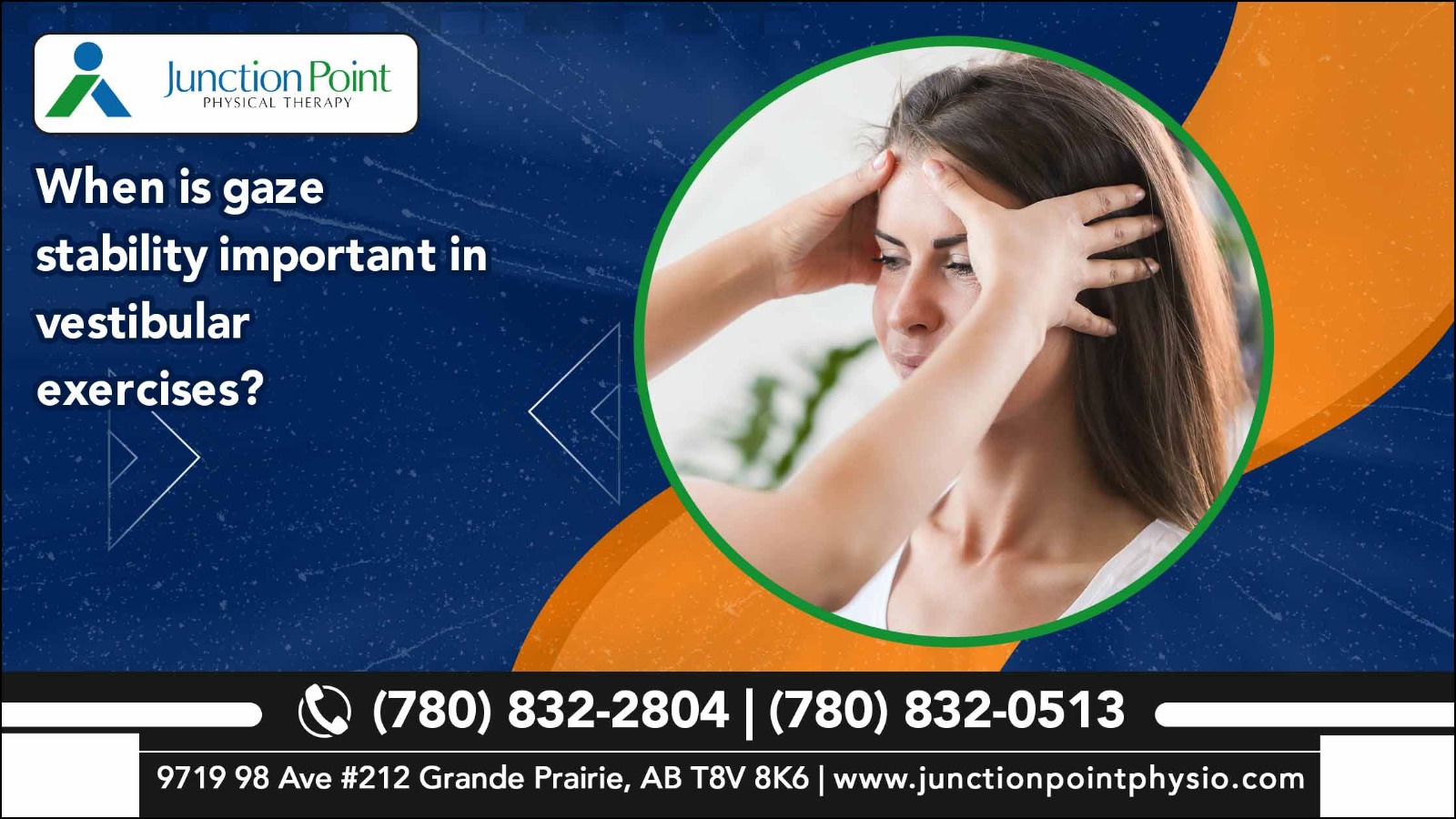Gaze stability plays a crucial role in vestibular exercises, serving as a fundamental component of rehabilitation for individuals experiencing vertigo, dizziness, and other balance disorders. Vestibular physiotherapy in Grande Prairie clinics offers specialized vestibular rehabilitation therapy to enhance this aspect of visual and physical coordination.
Through targeted exercises and therapeutic interventions, vestibular rehabilitation seeks to improve patients’ ability to maintain focus and stabilize their gaze, even while in motion or when their surroundings are moving. This aspect of treatment is particularly vital for those undergoing vertigo physiotherapy or dizziness physiotherapy, where the ability to control eye movements can significantly impact daily functioning and quality of life. By incorporating gaze stability exercises into a comprehensive rehabilitation plan, patients can achieve greater balance, reduce symptoms, and return to routine activities with improved confidence.
During the Acute Phase of Vertigo
Immediate Symptom Management
Patients may experience severe disorientation and imbalance in the acute phase of vertigo. Gaze stability exercises are designed to quickly mitigate these symptoms, allowing patients to regain a sense of equilibrium. Techniques used in vestibular physiotherapy in Grande Prairie, such as fixating gaze on a stationary object while moving the head, are fundamental in re-establishing vestibular balance.
For Patients with Chronic Dizziness
Long-term Adaptation and Improvement
Chronic dizziness often leads to prolonged instability, affecting daily activities. Vestibular rehabilitation in Grande Prairie emphasizes sustained gaze stability training, progressively increasing the difficulty of challenging the vestibular system and enhancing neural adaptation, significantly improving patients’ quality of life.
After a Diagnosis of Vestibular Disorders
Customized Rehabilitation Programs
Following a diagnosis of vestibular disorders, customized vestibular rehabilitation programs that include gaze stabilization are crucial. These programs are structured to address the specific unilateral or bilateral vestibular hypofunction disorder and are designed to restore balance and function as effectively as possible.
Post-Surgical Rehabilitation
Supporting Recovery Post-Vestibular Surgery
After surgeries impacting the vestibular system, such as labyrinthectomy or vestibular schwannoma removal, vestibular rehabilitation therapy, including gaze stability exercises, becomes essential. These exercises are critical in compensating for lost vestibular function, helping patients navigate their recovery with increased confidence.
As part of Fall Prevention Strategies
Reducing Fall Risk Through Improved Stability
Gaze stability exercises are key to fall prevention strategies, particularly for individuals at higher risk of falls due to vestibular issues. By improving the ability to maintain visual focus during movement, these exercises directly contribute to reducing fall incidents, a key objective of vertigo physiotherapy and dizziness physiotherapy in Grande Prairie.
For Athletes Recovering from Head Injuries
Facilitating Safe Return to Sport
Athletes recovering from head injuries require specialized vestibular rehabilitation to address any vestibular disturbances and ensure a safe return to their sports activities. Gaze stabilization exercises are integral, focusing on dynamic movements and scenarios that athletes might encounter. This ensures their vestibular system can handle the demands of their sport without inducing vertigo or balance issues.
During Everyday Activities
Enhancing Performance in Daily Life
Incorporating gaze stability exercises into vestibular rehabilitation therapy enhances performance in daily activities, enabling patients to perform tasks that involve head and body movements more efficiently. These could include navigating crowds, driving, or walking across uneven surfaces.
In Enhancing Cognitive Functions
Cognitive Benefits Linked to Vestibular Health
There’s growing evidence that improving vestibular health through exercises like gaze stabilization can positively affect cognitive functions, including attention and spatial orientation. This aspect of vestibular physiotherapy in Grande Prairie highlights the interconnectedness of physical and cognitive health, especially in rehabilitation contexts.
When Are Gaze Stability Exercises Used?
Gaze stability exercises are utilized in the following ways:
- Rehabilitation from vestibular disorders like BPPV (Benign Paroxysmal Positional Vertigo), labyrinthitis, or vestibular neuritis.
- Recuperating from a concussion or traumatic brain injury (TBI) with implications for the vestibular system.
- Management of symptoms in conditions like Meniere’s disease or age-related balance impairments.
Types of Gaze Stability Exercises
VOR (Vestibulo-Ocular Reflex) Exercises
The VOR is a mechanism that stabilizes gaze during head movements, allowing for clear vision while moving. VOR exercises involve moving the head side to side or up and down while focusing on a stationary target. These exercises can be adjusted in speed and complexity as the patient’s ability improves.
Smooth Pursuit Exercises
Smooth pursuit movements involve the eyes smoothly following a moving target. Exercises may include watching and following an object as it moves in different patterns, helping to enhance the coordination between the eyes and the brain.
Fixation Exercise
This involves focusing on a single target while performing various head movements. The goal is to maintain a clear focus on the target despite motion, improving the vestibular system’s ability to compensate for changes and stabilize vision.
Stabilizing the Horizon
In conclusion, gaze stability is not just an important aspect of vestibular exercises; it’s a cornerstone of effective vestibular rehabilitation. It’s essential for individuals suffering from vertigo, dizziness, and balance disorders, providing a foundation to rebuild their confidence in moving through and interacting with their environment.
Vestibular physiotherapy, especially within clinics like Junction Point Physical Therapy in Grande Prairie, focuses on integrating gaze stability exercises into comprehensive treatment plans. These exercises are crucial for enhancing the vestibular system’s function, improving patients’ quality of life, and facilitating a return to normalcy. Whether you’re struggling with persistent dizziness, vertigo, or balance issues, our vestibular physiotherapy program is designed to help you regain stability and navigate life with renewed assurance.
If you or someone you know needs vestibular rehabilitation, don’t hesitate to contact Junction Point Physical Therapy in Grande Prairie. Our team is ready to guide you through a tailored vestibular physiotherapy program, focusing on gaze stability exercises critical for recovery and long-term vestibular health. Let us help you regain your footing with compassionate care and specialized expertise.
